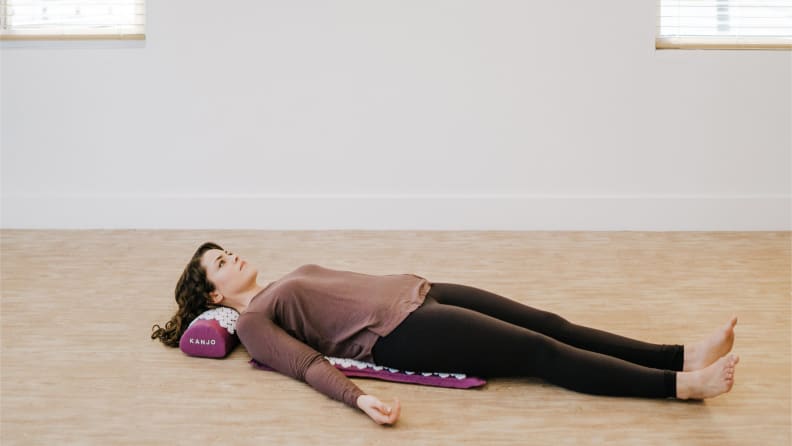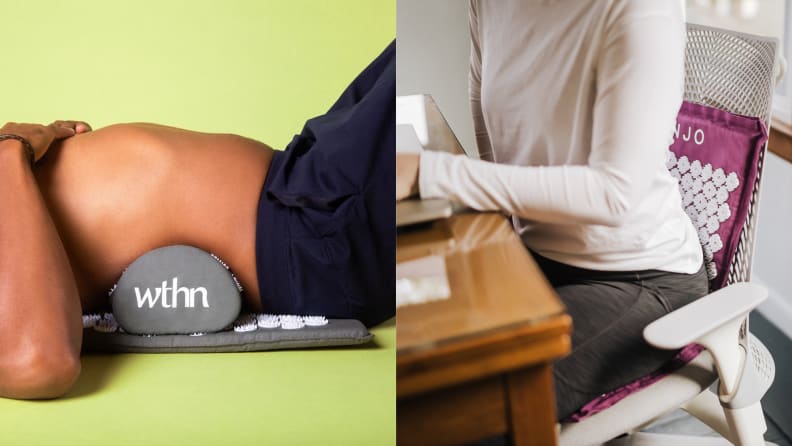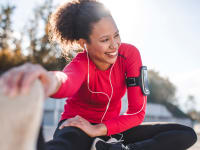Can you get the benefits of massage from lying on an acupressure mat?
Those little spikes do more than you'd think.
Products are chosen independently by our editors. Purchases made through our links may earn us a commission.
Between massage guns, foam rollers, and those bizarre rolling devices, there's no shortage of options for loosening up those taut, tired muscles many of us have. And, if those achy muscles primarily take up residence in your back and neck, you have another possibility: An acupressure mat—a flat rectangle of foam bedecked with spiky plastic nubs.
Many acupressure mat users—and, of course, the makers of said mats—claim they can provide massage-like benefits simply by lying down on them, such as reducing neck and back aches, stress and insomnia, headaches, and general muscle tension and soreness from exercise or sitting still all day. But do these mats live up to the hype? Here's what you need to know.
What is an acupressure mat?
A typical acupressure mat looks a lot like a sleeping pad—except for its length, which is meant to stop a little past the hips, and, of course, its surface, which is covered in hundreds of little spikes that are usually made of plastic. These spikes apply pressure via gravity to various points on the body when you rest—usually your back—on top of them. Most mat options also come with a pillow that's also covered in spikes to allow for more specific pressure on the head and neck. Lying on these prongs is meant to mimic acupressure massage, a component of Chinese medicine, which can help loosen up muscles and stimulate a flow of energy.
If it feels like you’ve been seeing a lot of acupressure mats—on social media, at various wellness retailers, in your friends’ living rooms—that’s because they’ve become a lot more common over the past year. “During the pandemic, with reduced normal access to healthcare and increased stress and anxiety, acupressure mats have become increasingly popular,” says Joanna Perkins, a Wales-based physical therapist who specializes in sports medicine.
Visually, there isn’t a ton of variation between most acupressure mats—most have spikes arranged in seashell-like circular formations atop the mat and an accompanying neck pillow. Because it’s a device intended for wellness, you can get acupressure mats with FSA money, or tax-free money from a special account that's used to pay for out-of-pocket healthcare costs. Top-rated options include mats from Wthn, Nayoya, Ajna, and Kanjo, and prices range from about $40 for the Nayoya mat and pillow to $80 for the Kanjo mat and pillow.
How do acupressure mats work?

Acupressure mats apply pressure to specific points on the back and neck, which may help provide relief from chronic pain.
Much like acupuncture and massage, acupressure mats work by applying, well, pressure to specific points on muscles, which helps promote blood flow in that particular area. To be clear, acupressure is not the same as acupuncture, which involves a professional inserting small needles into certain spots, or acupoints, on the body. Acupressure isn't as invasive, but it may affect the same places on the body (which, in the case of a mat, is the back and neck), if without the same intensity a needle might give. In fact, if you’ve ever thought about trying acupuncture but feel leery of the needles, you can try an acupressure mat or massage. They offer “a very similar therapy without actually penetrating the skin,” according to Perkins.
Benefits of acupressure massage include reducing various types of chronic pain, from menstrual cramps to headaches to low back pain, and some relief from anxiety. “Meridians of energy circulating through our body are targeted [with acupressure massage],” says Perkins. “The design of an acupressure mat stimulates pressure points near these meridians, meaning that the tensions and energy can flow freely.”
While there isn't a large body of research on acupressure mats, one study shows that acupressure mats can help provide relief from chronic neck and back pain.
Who should avoid using an acupressure mat?
It’s important to remember that acupressure mats shouldn't be used instead of advised or prescribed medical treatments—even if your mat feels fantastic, it doesn't mean you should skip your doctor’s advice.
Perkins says that people with conditions that result in skin being easily irritated or broken should consult a doctor before using an acupressure mat. People with high blood pressure should talk to a doctor before using one, too. Most acupressure mat manufacturers don't recommend pregnant people use them, and children and babies should also avoid contact with the mats. Additionally, people with mobility issues may find it difficult to lie down safely onto a mat and get back up again. If that’s the case for you, make sure to have someone close by to help you up or modify its use by placing the mat on a seat.
How do I use an acupressure mat?

You can use an acupressure mat by lying on it or placing it on a chair.
Acupressure mats may seem self-explanatory, but when your body is involved, it’s useful to follow best practice techniques to a tee. First, put your acupressure mat on a flat surface like your bed, sofa, or the floor. You can also put the mat at the back of your chair if you’d prefer to try it sitting up at first. Make sure to be careful when lying on the mat and avoid fidgeting around—this may have the unintended effect of scratching or injuring your skin. When first using the mat, it can be helpful to wear a t-shirt or lay a thin blanket over the mat so that you don’t feel an initial shock when using the mat. Once you’ve adjusted, bare skin to mat usually has the best impact.
Then, you can lie (or sit) on the mat for 15 to 20 minutes. The spikes may feel a bit strange or uncomfortable at first, but after a few moments your body should adjust, and the spikes will start to provide soothing pressure. You should never feel extreme pain on the mat—if you do, something is wrong. Consistent use, or at least five days a week for about a month— will help you become more comfortable with the mat and reap its physical benefits.


